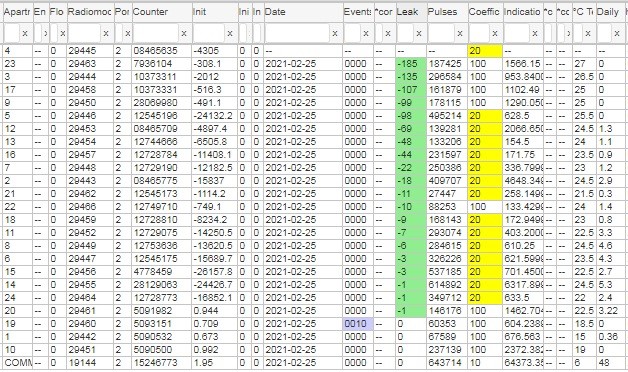The software of the BALANCE metering system, along with the calculation of hourly balances and analytics for identifying losses based on correlation, supports the calculation of the inadequacy coefficient: an abnormally high temperature inside the room with a low or zero volume of gas consumption. The coefficient of inadequacy makes sense only during the heating season, in addition, it is rather arbitrary, since it does not take into account the areas of heated apartments, the temperature in neighboring rooms and the error in measuring the temperature by the radio module can reach 2’C.
To calculate the inadequacy coefficient for objects, you need to run the function “get_object_table_for_temp_thief”) at the level of the hierarchical tree of objects.
After calculation, the dimensionless coefficient of inadequacy is displayed in the Fleak column, which is conveniently sorted in descending order. to search for the most suspicious objects.
The inadequacy coefficient is calculated for the selected date, for example, January 31 and the selected depth of analysis (by default, 7 days, but you can select the depth of analysis up to 30 days)
After selecting the object of interest in the list of objects – for example Testemiteanu_17 / 6, in the drop-down menu for this object you need to start the calculation “get_slave_info _temp_thief”. After calculation, the coefficient of inadequacy is displayed in the Leak column, which we sort in descending order to find the most suspicious apartments.
The analysis of the results of the work of the analytical module of the program makes it possible to identify apartments with inaccurate accounting of natural gas consumption.

For example, in the above table, the temperature in the top five apartments with zero gas consumption in winter is at least 25.5’C, which is of interest.
In apartments 23, 3, 17, 9 and 5 it is highly advisable to check how the owners maintain such a high temperature without gas consumption.
This option for determining losses is indirect, and does not give 100% of the result, for example, there are combined apartments with two gas meters and gas for heating is consumed from another gas meter. It is possible that there are neighboring apartments with small children in which the temperature is maintained at a very high level, which is sufficient for heating the neighboring apartments.
This function – the coefficient of inadequacy – is available for radio modules 11 software version and higher, which transmit the temperature parameter to “zero” hours in the “B2” field.
The most recommended use of the inadequacy coefficient is when the balance of the consumed gas in apartments is different and the readings of the general house metering device. In this case, first of all, metering devices are checked, revealed by the analytics of the coincidence of consumption profiles and the imbalance profile, as well as apartments with an increased inadequacy coefficient and of course apartments where the accounting system warns of incorrect data – sensor breakage, short circuit, exposure to an external magnetic field or bounce sensor. Further, the operator analyzes the information received and decides on the need for additional verification of the metering device.
BALANCE mobile application for Android here: https://play.google.com/store/apps/details?id=com.djv.balance
More information about BALANCE is on the website www.djv-com.org, and we will be glad to hear your suggestions at office@djv-com.net.

